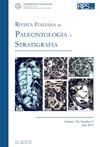STUDIES ON PYCNODONT FISHES (II): REVISION OF THE SUBFAMILY PYCNODONTINAE, WITH SPECIAL REFERENCE TO ITALIAN FORMS
IF 1.9
3区 地球科学
Q2 GEOLOGY
引用次数: 0
Abstract
The diagnosis, composition, and phylogenetic relationships of the European subfamily Pycnodontinae are revised; its record is pushed back from the Cenozoic into the Mesozoic. The Pycnodontinae is confirmed as a monophyletic group. It is diagnosed by: thin, laminar supraoccipital exposed all along the posterior border of the skull roof; cleithrum with two posterior expansions framing the notch for the pectoral fin; reduction in the ossification of the flank scales (clathrate pattern); reduction of the preopercular into a very low bone, never higher than the exposed, ornamented portion of the dermohyomandibular; and presence of a bifid cloacal scale. The subfamily includes the tribe Pycnodontini (Pycnodus + Oropycnodus), Polazzodus, Sylvienodus, and Tergestinia. The former “Coelodus” gridellii is moved to Polazzodus gridellii n. comb. The Italian genera, Pycnodus, Polazzodus, and Tergestinia, form a monophyletic group together with the French Oropycnodus. The present analysis shows that Polazzodus, Sylvienodus, and Tergestinia are pycnodontin fishes, but. Haqelpycnodus, Libanopycnodus, Scalacurvichthys, and Sigmapycnodus do not belong to the Pycnodontinae. “Pseudopycnodus” and “P. nardoensis” are considered nomina dubia. This revision has revealed new aspects of the last known diversification in the evolutionary history of the Pycnodontiformes, showing that the group was still thriving in the Western Tethys during the Late Cretaceous. For the present analysis, additional arguments involving ontogenetic restrictions are provided to favour ordering multistate characters in pycnodonts.扁口鱼的研究(II):对扁口鱼亚科的修订,特别是对意大利鱼类的修订
对欧洲扁牙亚科的诊断、组成和系统发育关系进行了修订;它的记录被从新生代推回到中生代。Pycnodotinae被确认为一个单系群。它的诊断是:沿着颅骨顶部的后边界暴露的薄的、层状的枕上骨;胸鳍有两个后部扩张,构成胸鳍的切口;侧鳞骨化减少(网格状);将经皮前骨缩小为非常低的骨头,永远不会高于裸露的、有装饰的下颌皮肤部分;阴沟裂鳞的存在。该亚科包括Pycnodotini部落(Pycnodus+Oropycnodus)、Polazzodus、Sylvienodus和Tergestinia。以前的“科埃洛杜斯·格里德利”被移到Polazzodus gridellii n.comb。意大利的Pycnodus属、Polazzodus属和Tergestinia属与法国的Oropycnodus组成一个单系群。目前的分析表明,Polazzodus、Sylvienodus和Tergestina是扁齿鱼,但。Haqelpyknods、Libanopyknodes、Scalacurphithys和Sigmapycknods不属于扁齿藻科。“Pseudopycnodus”和“P.nardoensis”被认为是名词dubia。这一修订揭示了扁齿形目进化史上最后一次已知多样化的新方面,表明该类群在白垩纪晚期仍在特提斯西部蓬勃发展。在本分析中,提供了涉及个体遗传学限制的额外论点,以支持对比重瓶中的多状态特征进行排序。
本文章由计算机程序翻译,如有差异,请以英文原文为准。
求助全文
约1分钟内获得全文
求助全文
来源期刊
CiteScore
3.60
自引率
4.30%
发文量
28
审稿时长
>12 weeks
期刊介绍:
The Rivista Italiana di Paleontologia e Stratigrafia was founded in 1895. It publishes original papers dealing with all fields of paleontology and of stratigraphy, from Italy and the Mediterranean to the Tethys, as well across the globe from China to North America.

 求助内容:
求助内容: 应助结果提醒方式:
应助结果提醒方式:


